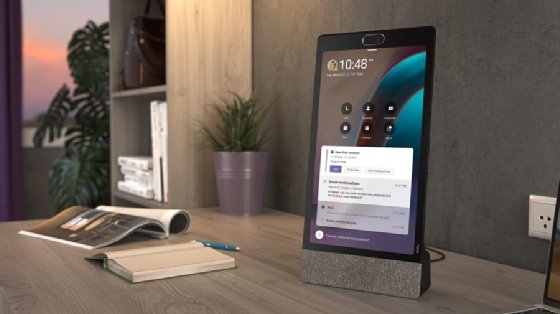
Rymden - stock.adobe.com
Desktop video conferencing hardware now built for hybrid work
Desktop video hardware offers organizations hybrid work benefits, including high-quality video for home workers and simplified IT management. But getting buy-in can be a challenge.
Video remains a key component of collaboration as the workplace evolves. And, now, employee expectations for video have increased -- not just in the quality of video meeting software, but in the devices used to facilitate video.
Webcams built into laptops often fall short of user expectations for high-quality video. Desktop video conferencing hardware -- such as external webcams, video bars and all-in-one systems -- are key in supporting video for both home-based and office workers.
These devices have become invaluable to employees who've experienced the more advanced capabilities built into these devices, including background noise reduction and autoframing, Metrigy analyst Irwin Lazar said.
"It takes a lot of the frustration out of long meetings," he said.
How desktop devices support home-based workers
As organizations embrace the hybrid workplace, they must be careful to not build barriers between remote and in-office employees, said Snorre Kjesbu, senior vice president and general manager of Webex devices at Cisco.
When working from home, three factors are key: how you feel, how you appear and the amount of work you get done, Kjesbu said. Cisco considered these factors when designing Webex desktop devices to ensure high-quality audio and video so home workers look professional on camera even if they don't have a dedicated home office to work from, he said.
At video hardware startup Neat, the Neat Frame dedicated video device was designed for a slim footprint to make it easier for remote employees to make Zoom and Microsoft Teams video calls from anywhere.
The Neat Frame has a handle on the back so users can pick it up and take it wherever in the house they want to work, such as the kitchen or bedroom, Neat CEO Simen Teigre said.

Desktop video devices in the office
Use cases for desktop devices aren't limited to home workers. While Webex devices are used more at home, they all have hot desking capabilities, Kjesbu said. Generally, in hybrid workplaces, when employees go to the office, they're going when they need to collaborate in person. When they have downtime in between meetings, hot desking on a Webex device can turn a shared space into a personal one, he said.
About one-quarter of organizations take a shared desk approach to their offices, Lazar said. Typically, for hot desking, organizations outfit workspaces with a monitor, phone, webcam and headset. But 40% of organizations use all-in-one desktop video devices to support hot desking, he said.
These devices, like Cisco's Webex Desk Series, are monitors with integrated cameras, microphones and speakers and often include video collaboration capabilities. These devices also enable employees to work directly from the monitor or connect to their laptop.
Some hardware can also be connected to hybrid workplace provisioning software, like Wisp or WorkInSync, so the workspace can be configured for individual employee profiles, Lazar said.
Smaller meeting spaces, such as huddle rooms and phone booths, can also be outfitted with desktop video devices, Teigre said.
Organizations need to be efficient in how they use office space, he added. Setting up workspaces with multiple components -- such as laptops, webcams and headsets -- can become complicated. A single device that employees can log in to and access their calendar, chats and meetings creates more flexibility for hybrid work.
Enterprise video devices offer management benefits
An additional benefit of business-grade desktop video conferencing hardware is IT's ability to manage the components. Vendors such as Cisco, Logitech and Poly offer management capabilities for their devices, including device registration for employees, device configuration and device inventory, Lazar said.
"If you're having audio quality problems or configuration issues, your IT group can remotely access the device," he said. "That's an advantage of using an enterprise-grade device versus going out and buying a consumer camera."
For IT, maintaining and supporting video equipment is a major pain point, especially with home offices, Teigre said. This is one area where all-in-one dedicated devices have an advantage. A desktop setup with multiple devices creates various points where something could go wrong, he said.
"For larger enterprises, it's a headache," he said. A dedicated device is more scalable and reliable in terms of management, he said.
Challenges with organizational buy-in
While desktop video devices can play a role in supporting the hybrid workplace, hardware vendors still face challenges in selling these products. There is some trepidation over who pays for desktop devices, Lazar said.
"The willingness to pay is still unproven," he said. "They're not high-margin devices compared to the room systems that Logitech or Poly are selling."
For some organizations, it may be difficult to justify the cost of high-quality personal devices when some employees are happy with less expensive consumer webcams or their own personal earbuds, he said.
Some employees may also have trouble convincing their bosses to send devices to home workers, said David Maldow, founder of Let's Do Video.
Video hardware vendors like Poly and Logitech offer high-quality USB webcams, such as the Poly Studio P5 and Logitech C930e, at a more attractive price point, he said. These professional-grade devices include advanced features like intelligent framing and directional microphones. They are also compatible with most video conferencing services, including Teams, Webex, Zoom and Google Meet.
Integrations, reduced costs address adoption challenges
The biggest challenge for products like Neat Frame is getting people to try the devices and see their value in action, Teigre said.
"It looks like a tall iPad, it's pretty costly and if all it does is a video meeting -- why invest in that?" he said. The Neat Frame is designed to be a companion to laptops, where employees facilitate video on the Frame while managing content on their laptops. Organizations may also find value in use cases beyond hot desking and small meeting rooms, such as virtual receptionists, he said.
An upside to HP acquiring Poly is the ability to bundle HP's product line of monitors, keyboards and mice with Poly's personal video devices, Lazar said. Logitech has also started to more closely bridge its personal peripheral device and video collaboration businesses.
Cisco, for its part, offers bundling of Webex device packages depending on the type of work and the number of meetings employees have, Kjesbu said. Employee choices range from a simple USB camera that sits on their laptop to a Desk Pro 4K touchscreen. Employees can also pick a package that includes a desktop video device and a Meraki router so they have a 4G fallback network if their home wireless goes down, he said.
The contact center is another area where desktop video devices could see enterprise buy-in, Maldow said. If an organization is building a new contact center from scratch and wants all agents on video, these devices should be considered, he said.








